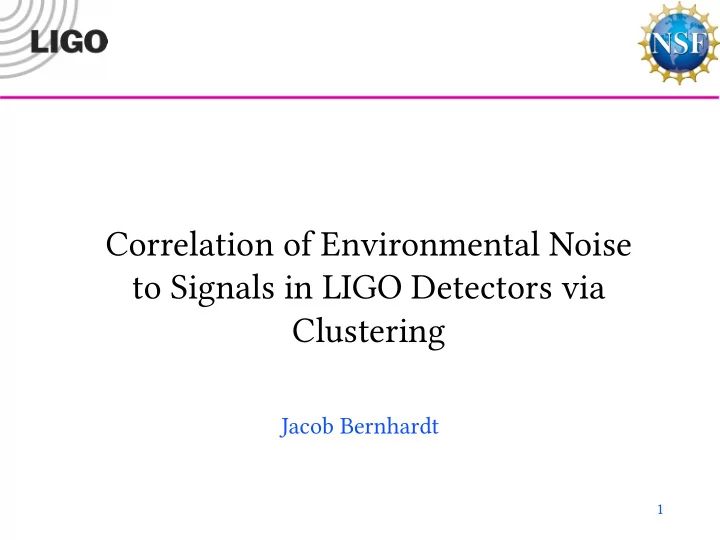

Correlation of Environmental Noise to Signals in LIGO Detectors via Clustering Jacob Bernhardt 1
Clustering 2
Clustering 3
k -means with Histories { s ( t 0 ) ,s ( t − 1 ) ,s ( t − 2 ) , ⋯ ,s ( t − n ) } Coordinates of a point in the clustering subspace for a channel, with s(t) the channel amplitude time t. 4
Known States: Seismic BLRMS Identified with “2-hour history” k -means over 30 days: • Earthquakes (0.01 to 0.1 Hz) • Microseisms (0.1 to 1 Hz) • Anthropogenic noise (1 to 10 Hz) Optimized: • length of history / number of clusters • size of clustering space 5
Known States: Seismic BLRMS Hz 0.01-0.1 0.1-1 1-10 E.Q. ~100x ~10% ~0% µSeism ~50% ~250% ~10% Anthro ~80% ~10% ~200% 6
Acoustic States BLRMS: Hz 10-28 28-32 32-50 10-28 28-32 (HVAC) LVEA 109% 95% 176% 32-50 PLUSX 87% 89% 50-70 70-100 PLUSY 131% 83% 165% 100-200 Longer (hours) cluster, less loud, locked times Qujick loud burst cluster @ lock-losses Hz 32-50 50-70 LVEA 1112% 890% PLUSX 1183% 1034% PLUSY 1100% 7
Clustering with DARM DARM BLRMS*: Longer (hours) cluster, less loud, locked times 10-13 18-22 Hz 22-27 27-29 29-40 22-27 GDS-CALIB_STRAIN 1% 3% 1% 27-29 29-40 40-54 54-65 65-76 75-115 115-190 190-210 210-290 290-480 526-590 590-650 650-885 885-970 1110-1430 8 *aLIGO LLO Logbook entry 453374 by Gabriele Vajente
Accelerometer States BLRMS: BSC focus Hz 4-10 1-4 4-10 Infrequent burst EX BSC4 X 427% 10-28 EX BSC4 Z 884% 28-32 32-48 48-60 60-80 Hz 48-60 60-80 80-118 80-118 MY VEA BTUBE 256% 259% 123% 118-122 122-200 EY BSC5 Z 108% ~1/2 day Beamtube focus Hz 48-60 MY 2100Y BTUBE 618% 9
Clustering with DARM Hz 48-60 54-65 MY 2100Y BTUBE 618% GDS-CALIB_STRAIN 38% 10
Next Steps • Focus on DARM – Try clustering only observing times • More small PEM subsets – Many channels in few bands – Many bands in few channels – Target new sensors 11
Acknowledgments Special thanks to: Anamaria Effler Rana Adhikari All LLO Staff Alan Weinstein & the coordinators of SURF 12
Appendix 13
Recommend
More recommend